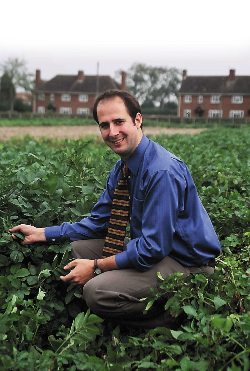
The risks of planting untreated seed that appears healthy but that harbours disease-causing organisms – invisible to the naked eye – was demonstrated on the Certis stand at British Potato 2005.
A seed tuber displayed for inspection was blemish-free with no visible symptoms of infection. "From looking at this potato tuber, it would seem reasonable to pass it as disease-free and fit for planting," said Peter Shakespeare of Certis. But, closer inspection with the microscope reveals a different story.
Microscopic examination
Only on microscopic examination were the fungal strands, or hyphae, of the rhizoctonia fungus (Rhizoctonia solani) visible. Facilitating the demonstration Dr Matthew Back of Harper Adams University explained that while the actual rhizoctonia disease, black scurf, is not expressed on the tuber, the organism that causes the disease can be seen under the microscope.
According to Dr Back, this is a common problem. Urging growers to get seed tested, he pointed out that the 'Eye Plug Test' service is offered by Harper Adams. Seed-borne disease levels are measured and typically the actual incidence of pathogens is much higher than expected. "10-20% infection is common, and if this seed is untreated then the fungus is stimulated when the shoots emerge, causing weakened growth due to stem canker, and black scurf blemishes can later appear on the surface of the daughter tubers at harvest," he warned.
Seed treatment
Peter Shakespeare noted that unlike other diseases where treatment after infection is too late, an application of a seed treatment such as RhiNo (flutolanil) will counteract the rhizoctonia organism giving the seed the best possible start. RhiNo is the most recent addition to the potato seed treatment armoury and delivers preventative and curative activity.
Mr Shakespeare added that seed-borne infection will not be controlled with a soil treatment that is only active on rhizoctonia infection already present in the soil. "But, a seed treatment will stop infection being introduced to the soil and onto the crop," he said.
